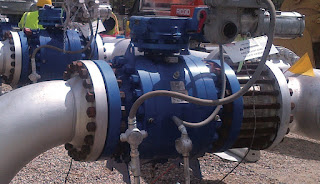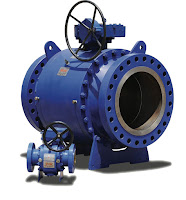 |
| Electric Valve Actuator in Service (Limitorque) |
Electric Valve Actuation Advantages
- Electric power is relatively inexpensive, easy to manage, and normally available to most industrial sites. The capital cost of electric actuators is typically cheaper per equivalent unit of torque/thrust output. They’re also cleaner and safer to operate.
- Electric actuators can provide superior positioning accuracy for control or modulating valve functions, which can include provisions for a high degree of process monitoring, data logging and information feedback.
- All necessary control functions are integral to electric actuators, reducing capital costs.
- Electric actuators significantly reduce control wiring costs by enabling distributed control. They simplify control logic by integrating control commands and feedback into customer SCADA or DCS systems. (Traditional electromechanical control systems require a dedicated wire for each command and feedback signal, leading to cable bundles with seven or more cores as minimum for each actuator. By contrast, a typical bus system can use one twisted pair wire in a daisy chain configuration to carry all required input and output signals.)
- As torque and thrust requirements increase, electric actuators weigh less and have smaller footprints compared to pneumatic actuators.
- Electric actuators may be combined with external gearboxes to produce extremely high output thrust and torque values.
Electric Valve Actuation Disadvantages
- With the exception of a few specific configurations, electric actuators can’t guarantee a fail-safe stroke but will “fail in the last position.” (Fail-safe stroke refers to an actuator’s ability to move a valve to a predefined safe position when power fails).
- Electric actuators have more complex and sensitive components than the mechanical parts used in other types of actuators. Electronic technology also requires periodic refreshing to keep pace with component changes and improvements.
- Beyond a certain size/torque range, electric actuators are less cost-effective and generally have limitations in operating speed when compared to pneumatic and hydraulic actuators.
- In hazardous areas with potential exposure to explosive process media, electric actuators require more specific certifications and construction features to be considered safe for use.
Recommended applications for electric actuation.
Electric actuation is the first choice for most oil and gas applications. They’re ideal for general process valve automation, non-critical applications, and light-duty modulating applications (generally up to 1200 starts per hour), although some can modulate continuously up to 3600 starts per hour.
For more information about electric valve actuation, contact Swanson Flo. Call them at 800-288-7926 or visit their web site at https://swansonflo.com.
Reprinted with permission from Flowserve Limitorque.








